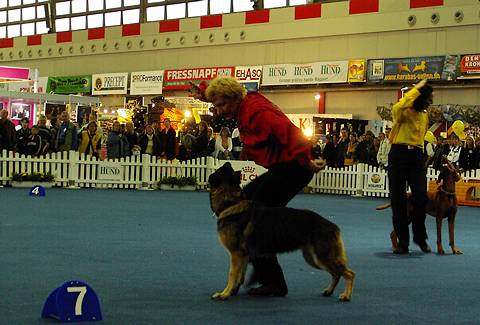|
<< -- 2 -- Tess Crebbin CANINE CHOREOGRAPHY

From his work with children, the professor says, he found out that, until about age 7 or 9 with human children, the artistic learning process of dog and human is very similar, '... because learning is primarily based on emotional aspects. Emotion, not intellect, lays the foundation for a solid learning base in both, dogs and young humans.'
When teaching children how to read notes, Professor Lind uses playful aspects, working with a lot of symbols and drawings. 'Dogs also react very well to symbols,' he explains, 'and they have a wonderful innate sense of rhythm.'
He says we do not know enough about the sense of hearing in dogs to confirm that they really hear seven times louder than humans, but they have got a very developed sense of hearing and this makes them highly sensitive to working with music.
'I found out that dogs in general do not seem to have a particular preference for classical or pop music,' he says, 'but rather that they seem to react well to anything that transmits a sense of joy and well-being. So I mix my choreography between classical and modern pieces. In the field of classical music, I have found out that the music needs to have a pronounced sense of rhythm and that it needs to flow well. This is why composers like Bach, Vivaldi, Pachelbel or Mozart, are very suitable. Also, dogs do not like most contemporary classical pieces, because they do not react well to atonality.'
Dogs, it seems, have a pronounced liking for the finer aspects of music and they are highly sensitive to the emotions that a particular piece of music conveys. 'When choreographing for dogs,' he explains, 'you also have to keep in mind that they cannot grasp abstract concepts. So the emotions that the music conveys to them need to be uplifting. Working with Bruckner, for instance, or with something like Mahler's 3rd, can be potentially very damaging to a dog. You cannot ask the dog to "play" aggression or sadness; he is sad or aggressive. He cannot switch his emotions on or off like an actor or a human ballet dancer can. The dog dances to synchronized steps that are driven by a very real emotional response to the music.'

Canine dance in motion: the Lind-art company at Dortmund 2005. Photo © Philip Crebbin
|
The professor, who studied choreography in Vienna, among others with the Brazilian Fernando Quello, a former ballet director in Salzburg, also thinks that dogs are faster to pick up on choreography than humans. 'I am amazed,' he muses, 'at how many human ballet dancers lack a profound understanding of music. It would be preferable for ballet dancers to have a classical music education as a prerequisite. What we see now in human choreographies is the need for a lot of repetitions during rehearsal and practice sessions, often sheer endless repetitions. This is because the dancers simply do not understand how composition works, how a particular piece is put together at the score level. With our dogs, we don't have this problem. They are faster to catch on to things, because they focus on the music and its innate rhythm, as though there were a solid understanding of this. They are so fast to catch on and tend to get bored quickly, so I prefer to steer away from endless repetitions and instead I concentrate a lot on improvising.'
Continue >>
Copyright © 15 May 2005
Tess Crebbin, Germany

|

